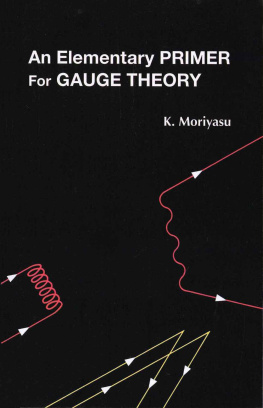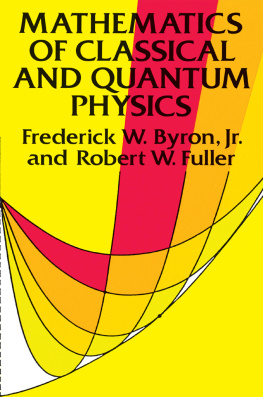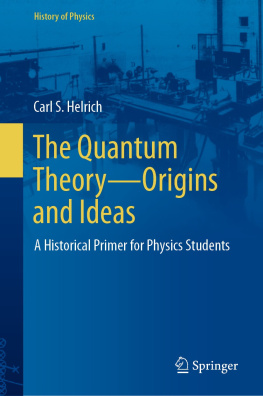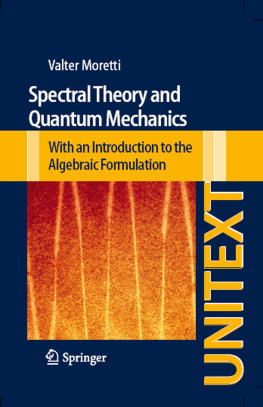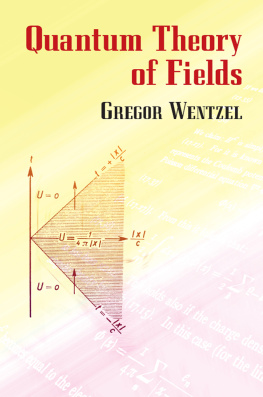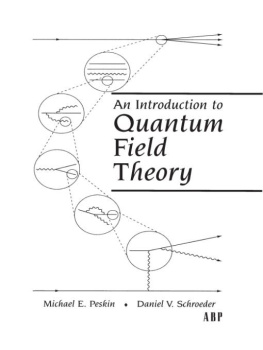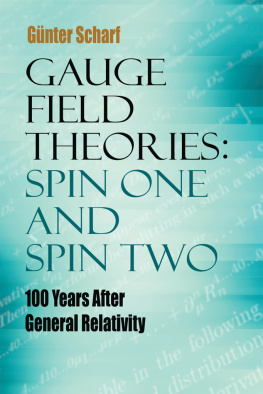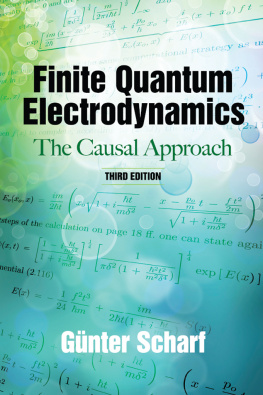An Elementary PRIMER
For GAUGE THEORY

Published by
World Scientific Publishing Co. Pte. Ltd.
5 Toh Tack Link, Singapore 596224
USA office: 27 Warren Street, Suite 401-402, Hackensack, NJ 07601
UK office: 57 Shelton Street, Covent Garden, London WC2H 9HE
Library of Congress Cataloging-in-Publication Data
Moriyasu, K.
An elementary primer for gauge theory / K. Moriyasu.
p. cm.
Includes bibliographical references and index.
ISBN-13 978-9971-950-83-5
ISBN-10 9971-950-83-9
ISBN-13 978-9971-950-94-1 (pbk)
ISBN-10 9971-950-94-4 (pbk)
1. Gauge fields (Physics). I. Title.
QC793.3.F5 M67 1983
530.143--dc19
84147918
British Library Cataloguing-in-Publication Data
A catalogue record for this book is available from the British Library.
First published 1983
Reprinted 1985, 2009
Copyright 1983 by World Scientific Publishing Co. Pte. Ltd.
All rights reserved. This book, or parts thereof, may not be reproduced in any form or by any means, electronic or mechanical, including photocopying, recording or any information storage and retrieval system now known or to be invented, without written permission from the Publisher.
For photocopying of material in this volume, please pay a copying fee through the Copyright Clearance Center, Inc., 222 Rosewood Drive, Danvers, MA 01923, USA. In this case permission to photocopy is not required from the publisher.
Printed in Singapore by B & JO Enterprise
To My Parents
PREFACE
The understanding of nuclear and elementary particle physics has now reached a historical turning point. During the last decade, a revolution has quietly occurred a revolution called Gauge Theory. For the first time in 50 years, since the birth of modern nuclear physics, gauge theory allows us to understand how the fundamental forces of nature may be unified within a single coherent theory. The discovery of gauge theory rivals in importance the development of both relativity and quantum mechanics. In contrast to the situation less than 10 years ago, gauge theory now dominates nearly all phases of elementary particle physics today. Even the reasons for performing new experiments are now judged by their relevance for testing the predictions of gauge theory.
Clearly, such an exciting development should be widely accessible and understandable not only to theoreticians but also to experimental physicists, students and the intelligent layman as well. Like politics and war, gauge theory has become too important to be left only to the experts. Unfortunately, for the reader who wishes to first understand the basic physical ideas behind gauge theory, the published literature can present a daunting challenge. The reason for the difficulty is that gauge theory represents a totally new synthesis of quantum mechanics and symmetry ideas which have been applied to the entire field of elementary particle physics.
I believe that gauge theory can be appreciated by the non-expert; that is the raison detre for this primer. In order to emphasize the physics of gauge theory rather than the mathematical formalism, I have used a new intuitive approach and designed the text primarily for the reader with only a background in quantum mechanics. My goal in this primer is to hopefully leave the reader with an appreciation of the elegance and beauty of gauge theory.
This book was motivated by my own desire as a non-expert to learn something about gauge theory. Over a period of 45 years, I wrote a series of short pedagogical articles on gauge theory topics for the American and European Journals of Physics. These articles allowed me to test the ideas and the writing style for this primer. I also found that trying to satisfy the high standards of the referees for these journals encouraged me to develop much clearer explanations for many gauge theory topics. I am indebted to these referees who do their work in anonymity.
K. Moriyasu | Seattle, |
July, 1983 |
CONTENTS
CHAPTER I
INTRODUCTION
... the best reason for believing in a renormalizable gauge theory of the weak and electromagnetic interactions is that it fits our preconceptions of what a fundamental field theory should be like.
S. Weinberg, 1974
Modern gauge theory has emerged as one of the most significant and far-reaching developments of physics in this century. It has allowed us for the first time to realize at least a part of the age old dream of unifying the fundamental forces of nature. We now believe that electromagnetism, that most useful of all forces, has been successfully unified with the nuclear weak interaction, the force which is responsible for radioactive decay. What is most remarkable about this unification is that these two forces differ in strength by a factor of nearly 100000. This brilliant accomplishment by the Weinberg-Salam gauge theory, and the insight gained from it, have encouraged the hope that all of the fundamental forces may be unified within a gauge theory framework. At the same time, it has been realized that the potential areas of application for gauge theory extend far beyond elementary particle physics. Although much of the impetus for gauge theory came from new discoveries in particle physics, the basic ideas behind gauge symmetry have also appeared in other areas as seemingly unrelated as condensed matter physics, non-linear wave phenomena and even pure mathematics. This diversity of interest in gauge theory indicates that it is in fact a very general area of study and not exclusively limited to elementary particles.
In this primer for gauge theory, our purpose is to present an elementary introduction which will provide an adequate background for appreciating both the new theoretical developments and the experimental investigations into gauge theory. We have therefore adopted a very general pedagogical approach which should be useful for very different areas of physics. Like any new topic in physics, the study of gauge theory requires some familiarity with background material from other areas of physics and mathematics. Gauge theory represents a new synthesis of quantum mechanics and symmetry. At the same time, it is also a direct descendent of quantum electrodynamics; thus much of the published literature on modern gauge theory is written in the language of renormalizable quantum field theory which has proven so useful in electrodynamics.
In this primer, we have adopted the point of view that it is possible to learn the fundamentals of gauge theory by using a much simpler semiclassical approach. By semiclassical, we mean Maxwells electromagnetism and old-fashioned Schrdinger quantum theory where the electromagnetic field is not second quantized. By using such an approach, we can emphasize the new physics of gauge theory without the added technical complexities of quantum field theory, A limitation of our approach is that we cannot discuss the problems associated with the quantization of gauge theory in any rigorous fashion. However, since these problems are among the most subtle and difficult in gauge theory, we feel that they can best be studied separately in more advanced treatments such as the excellent review of Abers and Lee.
One essential requisite for the study of gauge theory is at least a nodding acquaintance with some of the terminology of group theory. The heart of any gauge theory is the gauge symmetry group and the crucial role that it plays in determining the dynamics of the theory. Fortunately, much of the necessary group theory is already familiar to physics students from the treatment of angular momentum operators in quantum mechanics. The essential difference in gauge theory is that the symmetry group is not associated with any physical coordinate transformation in space-time. Gauge theory is based on an internal symmetry. Therefore, one cannot speak of angular momentum operators, but must replace them with the more abstract concept of group generators. This is more than a mere change of labels because the generators have mathematical properties which were previously ignored in quantum mechanics but are very useful in gauge theory. In particular, we will see that the proper understanding of gauge invariance leads naturally to a geometrical description of gauge theory that is both highly intuitive and strongly resembles the familiar geometrical picture of general relativity. By exploiting this geometrical feature of gauge theory, we can often find much simpler interpretations of complicated physical phenomena such as gauge symmetry breaking, which is one of the most important ingredients of the Weinberg-Salam theory.
Next page
